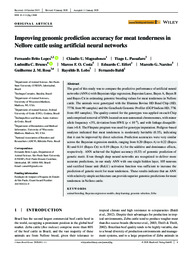Improving genomic prediction accuracy for meat tenderness in Nellore cattle using artificial neural networks.
Improving genomic prediction accuracy for meat tenderness in Nellore cattle using artificial neural networks.
Autoria: LOPES, F. B.; MAGNABOSCO, C. de U.; PASSAFARO, T. L.; BRUNES, L. C.; COSTA, M. F. O. e; EIFERT, E. da C.; NARCISO, M. G.; ROSA, G. J. M.; LOBO, R. B.; BALDI, F.
Resumo: The goal of this study was to compare the predictive performance of artificial neural networks (ANNs) with Bayesian ridge regression, Bayesian Lasso, Bayes A, Bayes B and Bayes Cπ in estimating genomic breeding values for meat tenderness in Nellore cattle. The animals were genotyped with the Illumina Bovine HD Bead Chip (HD, 777K from 90 samples) and the GeneSeek Genomic Profiler (GGP Indicus HD, 77K from 485 samples). The quality control for the genotypes was applied on each Chip and comprised removal of SNPs located on non‐autosomal chromosomes, with minor allele frequency <5%, deviation from HWE (p < 10?6), and with linkage disequilibrium >0.8. The FImpute program was used for genotype imputation. Pedigree‐based analyses indicated that meat tenderness is moderately heritable (0.35), indicating that it can be improved by direct selection. Prediction accuracies were very similar across the Bayesian regression models, ranging from 0.20 (Bayes A) to 0.22 (Bayes B) and 0.14 (Bayes Cπ) to 0.19 (Bayes A) for the additive and dominance effects, respectively. ANN achieved the highest accuracy (0.33) of genomic prediction of genetic merit. Even though deep neural networks are recognized to deliver more accurate predictions, in our study ANN with one single hidden layer, 105 neurons and rectified linear unit (ReLU) activation function was sufficient to increase the prediction of genetic merit for meat tenderness. These results indicate that an ANN with relatively simple architecture can provide superior genomic predictions for meat tenderness in Nellore cattle
Ano de publicação: 2020
Tipo de publicação: Artigo de periódico
Unidade: Embrapa Cerrados
Observações
1 - Por padrão são exibidas publicações dos últimos 20 anos. Para encontrar publicações mais antigas, configure o filtro ano de publicação, colocando o ano a partir do qual você deseja encontrar publicações. O filtro está na coluna da esquerda na busca acima.
2 - Para ler algumas publicações da Embrapa (apenas as que estão em formato ePub), é necessário ter, no celular ou computador, um desses softwares gratuitos. Sistemas Android: Google Play Livros; IOS: iBooks; Windows e Linux: software Calibre.
Acesse outras publicações
Acesse a Base de Dados da Pesquisa Agropecuária (BDPA) para consultar o acervo completo das bibliotecas da Embrapa.

